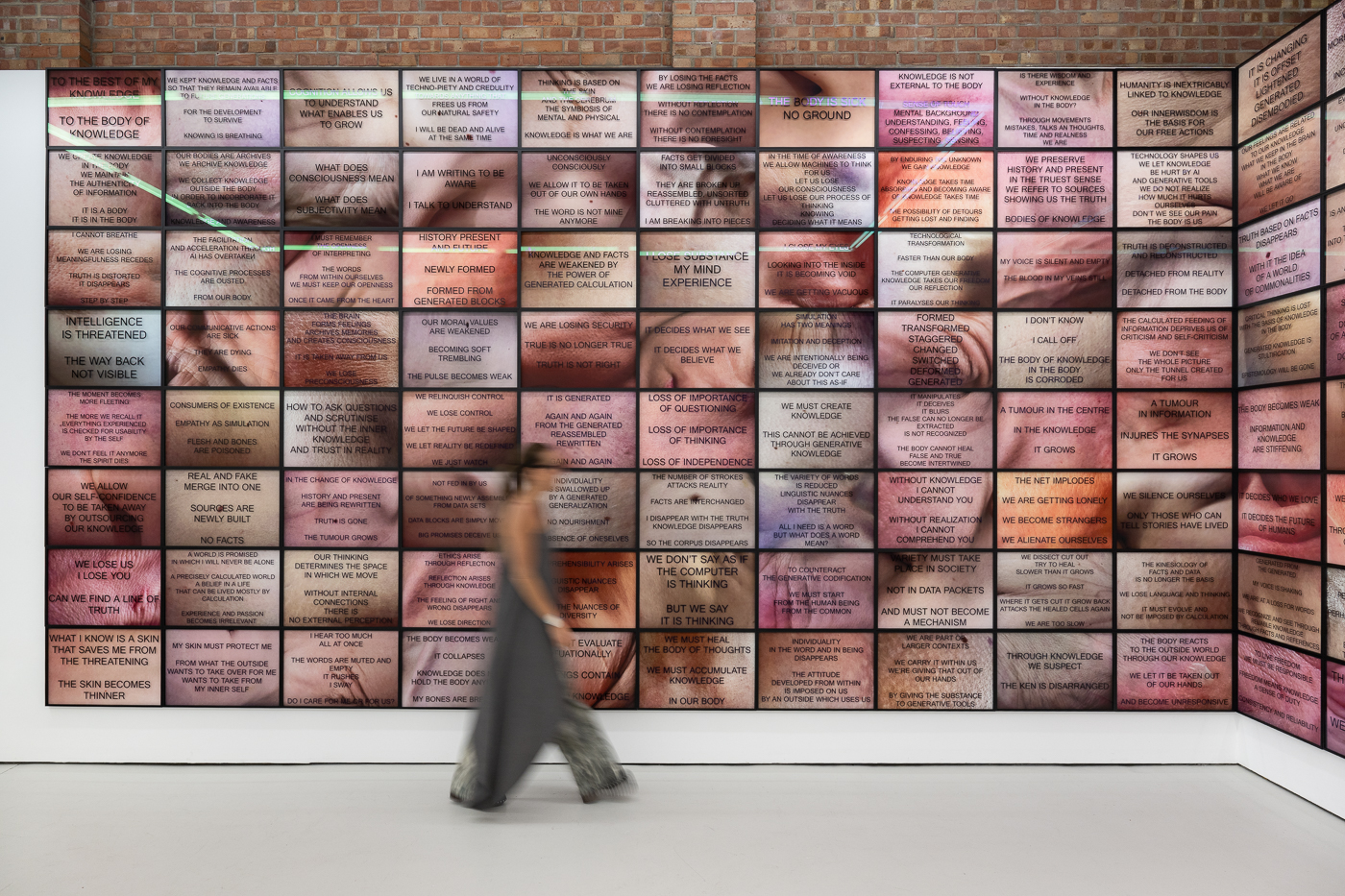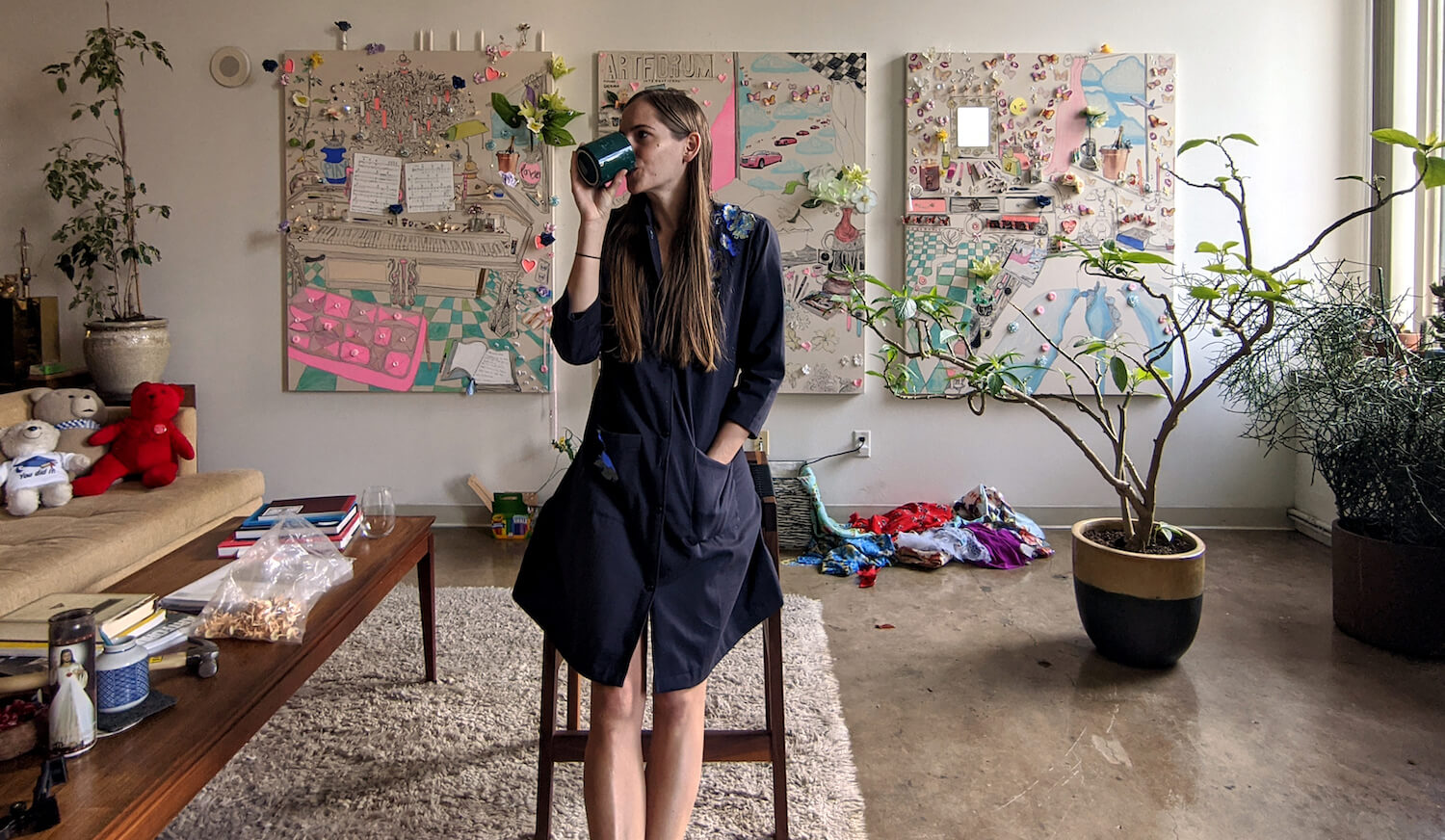Gretchen Andrew has been extensively profiled by Camilla Flocke in Wirtschafts Woche.
The Hypnotist
By Camilla Flocke
The artist Gretchen Andrew outwits the most sophisticated algorithm in the world with unicorns and flowers: Google’s search engine.
When the sun rises over Park City in the US state of
Utah at 5 a.m., Gretchen Andrew is already sitting between green and blue oil crayons, tubes of paint and sharpeners. She has cleared a small corner of the table, just big enough for her laptop. BecauseAndrew is not only a painter, but also a programmer: in the midst of this creative chaos, she outwits what is probably the most sophisticated algorithm in the world, Google’s search engine.
When people search for something on theInternet , nine out of ten use Google. Worldwide. What googIe doesn’t show, it doesn’t exist. The search engine is so important for companies that its own service industry has long since specialized in optimizing websites for Google.
Gretchen Andrew takes this madness to extremes in a certain way and has in turn created her own genre of art from it. She is a self-proclaimed search engine artist. For example, if you type “The next American president” into the Google search bar, the blue-white and black-and- white collages of Andrew appear next to the photos of Donald Trump and Joe Biden. And these have little in common with the two politicians. In addition to butterflies, flowers and shells, a collage adorns three different vases with the words“Love” and“Open” as well as a peace sign.
In doing so, she demonstrates the most famous of the algorithms that have penetrated deeper and deeper into our lives and determine our everyday lives more than ever. They suggest the right playlist for the mood in the streaming service and warn us of bad weather. But they also call up the highest prices for hotel rooms on booking platforms exactly when we need one most urgently. And keep showing us an ad on all kinds of websites for sneakers that we have long since ordered from Zalando.
Andrew’s art now proves that not only the algorithms can trick people – the game also works the other way round. Because some things that are child’s play for humans are very complicated for machines. We can see immediately that Andrew’s painting in no way shows a presidential candidate, nor does Google’s search algorithm. This is exactly what Andrew wants to make clear with her art: That the internet and its search engines are not as smart as we would like to believe. And so we shouldn’t trust them as uncritically as we usually do. “If I manipulate the search algorithm with my works, it is obvious to everyone.”
“Lasts longer than a collage”
In the beginning, search algorithms were still quite simple and understandable: all that counted was how often a search term appeared on a website. With white letters on a white background, websites could appear so quickly in the top search results. The algorithms are now more complex. They list websites higher, the more other pages link to them, if a text contains information that belongs together and is understandable for humans, and the longer users stay on a page. Google even adjusts its algorithm regularly to make manipulation more difficult – without revealing details.
“I have the feeling that the algorithm is getting dumber and not smarter,” says Andrew. In order to “hypnotize” them, as she calls it, she searches the Internet for websites where she can create her own profiles for her projects, such as the social network Pinterest or the recommendation portal Yelp.
There she links her project pages and updates the profiles regularly by uploading her works of art one by one. However, mostly in an annoyingly low resolution for an artist. The search algorithm rewards all of this. When formulating the accompanying texts, she is guided by the keywords in the results previously listed on Google. “All of this sometimes takes longer than creating the collages,” she says.
Dream job at Google
Programming, understanding how an algorithm works, Andrew learned all of this from her father, who owns a technology company. “We never had this way of thinking: men work with computers and women work with art.” After studying at the interface between computer science and management at Boston College, Andrew started her career in the software industry. She even worked at Google for two years. “My dream job at the time,” she says. So she experienced the Silicon Valley culture, paid off her student loan and was able to apply exactly what she had learned during her studies: to use information in such a way that it brings a competitive advantage. However, she did not get any deep insight into the secrets of the algorithm behind the search engine.
The slightly different kind of narrow-mindedness on Google
She worked in Google’s human resources department, developing software programs for employee data. A position that at some point made her no longer happy: “Even if Google and Silicon Valley are different from the rest of entrepreneurship in America, there is also a unanimous opinion there about what success looks like. “Ultimately, the culture there is just as narrow-minded as one Big bank, it’s just “another kind of bigotry,” said Andrew. In order to live out her creativity, Andrew left the tech scene and tried herself as an artist.
She was apprenticed to the British artist Billy Childish for five years. In addition to painting, she learned from him “above all to be herself”, she sums up this time. It was a long process: first, she mimicked her mentor’s style and, as is customary in the art world, titled these oil paintings as “after Billy Childish”. The Google algorithm, however, did not get it and soon listed her works under those of the British artist – and so gave Andrew the idea of her very own genre, search engine art.
She is currently following in Utah and not in Los Angeles as usual. During the coronavirus pandemic, she and her husband will be closer to nature with friends there, she says. On the canvas hanging on the garage wall, Andrew, who wears a tie-dye jacket with black sports trousers and a gray cap, draws the outlines of a vase and a table with a black pen.
Then she fetches photos of chairs cut out of magazines from the round side table, on which she also programs, and glues them on with a hot glue gun. She pulls a bouquet of pink plastic flowers from one of the boxes that are standing around on the floor and is filled with unicorn bathing ducks and glittering flags and attaches them to the canvas. The work of art is planned for her exhibition in London in 2021, in which she will address art schools and their degrees. She has not yet thought of a suitable catchphrase.
Without spreading gloom
As serious as the subject she deals with is, her works of art are playful. Colourful. Girlish. A contrast that she consciously chooses. Andrew describes herself as a happy person. And as such, she thinks, one can also approach melancholy subjects without any dark motifs and dark colours. After all, not only the criticisms of the mechanisms of the digital world determine her works, but also her dreams. One of them: to be successful in the art world.
Although she only seriously started her search engine art last year, she has made good progress, the 32-year-old is presenting her art in more and more galleries and exhibitions. “Everyone is talking about Gretchen Andrew at the moment,” says Annette Doms, an art historian who specialises in digital art. She herself got to know the artist about four years ago and found her to be “curious and absorbing”.
Anyone who believes the Google search alone could even count Andrew among the absolute world stars in their field. Your pictures appear when searching for covers of the international art magazine Artforum as well as when searching for last year’s “Whitney Biennial”, an exhibition for American contemporary art, and the “Frieze Los Angeles” art fair. She was never represented on any of the covers or exhibitions.


